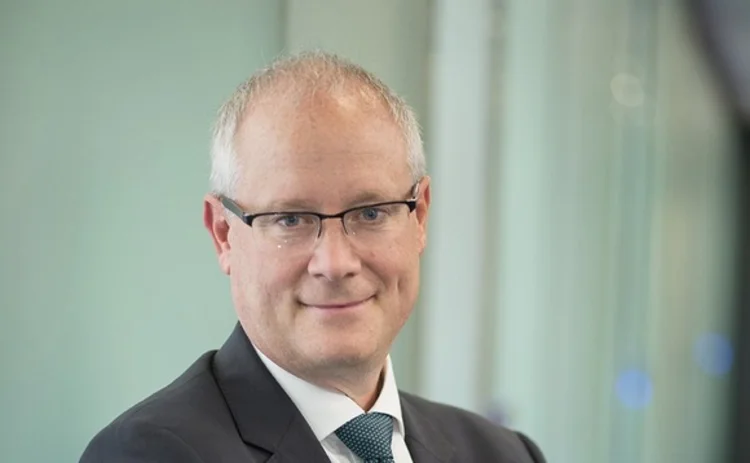Going Global: Stewart Carmichael, Schroders
Schroders' CTO discusses his career and the new things that the old firm is working on.

There are four basic aspects of globalization: trade and transaction, capital and investment movements, the migration of people, and the dissemination of knowledge. Each one of these elements is a key factor with untold levels of intricate subtleties that require far-reaching and precise insights. And usually, these tenets aren’t ever reached to a complete degree.
As the world has become more interconnected over the past few decades, many financial institutions have spread their wings both territorially and on their balance sheets. Some have succeeded, others have failed, while many are still on the journey.
The political upheaval and surprises on both sides of the Atlantic this year—most notably with the Brexit vote and election of Donald Trump as US president—has led some to question whether globalization is approaching a point of diminishing returns—that those four fundamental aspects have become so convoluted that the very idea is now unsustainable. However, the world doesn’t stop turning and that won’t be of too much concern to those capital markets participants that are making headway with globally minded projects of their own.
One man who knows the pitfalls, nuances and not-so-happy little surprises that go hand-in-hand with regional growth is Stewart Carmichael, CTO at Schroders, one of Europe’s largest asset management firms, with $466.9 billion under management.
Carmichael’s financial services career spans 25 years and numerous time zones. In the 1990s he walked the trading floors in New York and London. In the new millennium, he was at the vanguard of Hong Kong’s and Singapore’s burgeoning fintech scene. Now, he once again calls London home. He’s seen first-hand the effects of globalization in finance—both the good and the bad—and is now set in the task of embedding that experience into Schroders’ globally minded technological expansion.
“As you move to Agile, you are going to adopt new practices. It is going to change how you interact with your business sponsors. So it is not just a transformation for technology, it is a transformation for the whole organization, worldwide.”
Wide Scope
Carmichael joined the London-based firm in March last year, replacing the outgoing Matthew Oakeley, who had moved to Investec. Carmichael had spent the lion’s share of his career with Merrill Lynch in both the UK and the US. He has a broad remit at Schroders, as he’s responsible for the firm’s data strategy—both from an underlying technology perspective, and from an overarching architectural and governance perspective—and he assists in business change projects and management of the firm’s digital capabilities.
He says digital is a complex term due to the multiple dimensions involved. He likens it to the way big data was being discussed five years ago in terms of pinning down definitions and expectations of what can be delivered.
“We are analyzing other opportunities to use digital from a product and client perspective, and we are also looking at digital as a space where we can drive and incubate innovation within technology and the firm as a whole,” he says.
The thrust of Carmichael’s role is to expand Schroders on the world stage, which means ensuring that a firm established in 1804 and employing around 3,600 staff worldwide is prepared to take on rapidly changing, and often volatile, global trading environments.
Like other hoary institutions in finance, Schroders has legacy technology issues to address. When Carmichael joined, the firm’s board gave him three main imperatives that needed to be addressed immediately: increase the pace of change; derive the appropriate value from the investment Schroders was making in technology; and, arguably most importantly, manage risk.
“The conclusion that I and the team came to was that we needed to change how we were delivering technology, so we embarked on a transformation of the organization and the process,” he says. “We chose to adopt Agile as a change mechanism, specifically the Scaled Agile Framework (SAFe), which is the first iteration of the Agile framework that deals with enterprise organisations.”
The adoption of Agile methodologies certainly meets the requirements Schroders has set out in terms of improving the pace of change through a minimum viable product, while bringing the business closer to the technology. The result has been more collaborative and effective sprint implementations.
“As you move to Agile you are going to adopt new practices. It is going to change how you interact with your business sponsors,” Carmichael says. “So it is not just a transformation for technology, it is a transformation for the whole organization, worldwide.”
Changing Framework
Schroders’ adoption of Agile began in earnest at the start of the year and Carmichael says the goal is to be 75 percent complete by the end of 2016. The firm has also introduced DevOps—the practice of emphasizing the collaboration and communication of both software developers and other IT professionals—into its enterprise framework.
“What we have been able to observe so far is that it’s hugely empowering to the organization. The level of enthusiasm and energy of the people involved working this way is a great outcome,” he says.
There is also significant work being done on specific areas of the firm’s technology framework. The key criteria for Schroders lies in enhancing its capabilities in real-time risk management from a client perspective, developing and adopting new products in shorter time frames, and modifying or replacing its customer relationship management (CRM) technology.
One of the major projects for Schroders is the completion of a newly reengineered data warehouse. “We have built an architecture that we intend to develop on over the next three to five years as part of that journey of solving not only the data warehouse, but those locations in our architecture where we are going to master data, what the messaging is going to be, how those things are going to inter-relate, the governance over that data working with various COOs within the business, and making sure the right business ownership sits on top of that data, as well,” he explains.
Data has been a widespread issue for the asset management industry, with shortcomings based on legacy, storage and processing inadequacies, while data analytics tools are growing ever more critical when it comes to coping with increased regulatory pressure to display best execution and trading transparency.
In order to combat these issues, Schroders has—alongside its data warehouse development—been taking a new approach to data analytics. Peter Harrison took on the mantle of CEO at Schroders this summer after Michael Dobson stepped aside. It was seen as a creative and energetic force of change for the firm.
Carmichael says that over the last two years, Harrison has invested heavily in building teams of data scientists outside of the Schroders technology department to provide deeper insights into investment decision-making from a client analytics perspective. As he puts it: “We are building Iron Man suits, not trying to replace them with Terminators. We are trying to turn them into super heroes, not convert them into machines.”
He continues: “The capabilities of the different ways that you can analyze and cut data, and the new insights you can get to improve investment decisions is astounding. What the technology department is trying to do in that space is provide the standard tools and capabilities, and then make that capability much wider to the whole organization.”
Despite being a 200-year-old financial institution, Carmichael says Schroders keeps tabs on the likes of Silicon Valley in order to see where relevant products are being developed and how they can be applied to the financial services industry. Blockchain and distributed-ledger technologies, however, are not high up on the firm’s list of priorities. Schroders is engaged in some academic conversations on how these technologies can potentially be applied to areas such as smart contracts, but Carmichael says he is otherwise happy to keep an eye on developments, with the potential for some proof-of-concept work in the near future.
Schroders’ prudent approach to blockchain is symptomatic of the vision it is trying to achieve for its global operations. Rather than bet big on a technology that Carmichael believes won’t have genuine practical applications in the capital markets for at least another three to five years—a relatively optimistic timeframe compared to some other opinions—there are more pressing issues at hand.
Transatlantic Journeys
If you’re going to build out your IT footprint globally, it helps to have a leader with international experience. Carmichael began in London with Merrill Lynch in 1993, having previous technology experience with Sun Microsystems. This was long before banks had the kind of large-scale technology departments, division between production and development, and governance that exist today.
Jumping back and forth between the UK and the US, Carmichael took on a range of responsibilities with the bank. He redesigned networks and platforms to make them operate more efficiently. He ran non-dollar swaps on a global basis. He looked over European engineering after the institution moved to a regional structure.
In the late 1990s, he returned to the US, where he had run support for the bank’s North American trading floor operations. It was an experience that only those who were involved in the large sell-side trading floors of that era could ever really understand.
“At Merrill Lynch we had something like 2,000 positions just in New York alone, across equities, fixed income and commodities, and that would involve me being in the office before 7 a.m. in the hope that all trading systems and market data would be operating, and managing everything from there to Chicago to San Francisco for North America,” Carmichael says. “That was a great experience and learning curve working with a lot of different people, and some people who influenced my career for many years before and after that.”
Head East
Carmichael’s first opportunity to work on the buy side came upon his return to the UK at the turn of the new millennium, running application support for Merrill Lynch Investment Managers (MLIM), which had recently acquired UK fund manager Mercury Asset Management. From there, he went on to become CTO of Merrill Lynch’s international operations. A few years later, he would take on the challenge of setting up a new service center for the bank in Singapore.
“Although it was a technology function, it was also an operations and finance function, and probably even more interesting to me—although I didn’t know it at the time—it was an HR service center as well,” Carmichael says. “It is a completely different myriad of challenges if you have those four groups working for you.”
Much like any regional development site around that time, the Singapore location grew at a fast clip, going from 300 staff when Carmichael started to 2,000 in just 18 months. However, 2008 was not a year for plans to run smoothly for anyone in the capital markets.
Merrill Lynch experienced its share of disruption during the global credit crisis and on the day before the banking world was stunned by the collapse of Lehman Brothers, Bank of America (BoA) announced its plan to buy Merrill Lynch. Carmichael, however, recalls that he only learned of the deal the next day, Monday morning in Asia, by watching Bloomberg, as the news had yet to be officially communicated.
Given the choice between being a part of the new BoA Merrill Lynch structure or the possibility of joining JPMorgan, Carmichael chose the latter and headed to Hong Kong to take part in the bank’s transformative process, which included integrating another casualty of the credit crisis—Bear Stearns—into the institution.
“There was a strength of conviction about the journey JPMorgan needed to make to transform the technology platforms,” Carmichael says of his time in Hong Kong. “You can’t change a technology architecture within 12 months. You have to have a three- to five-year vision about what you are going to do and every year you have to come back and revisit. It is about perseverance as much as it is about vision. The great thing about JPMorgan at the time was that—and I don’t believe that has changed—though the organization shifted, changed and new business came in, they kept persevering with that vision.”
Returning to the UK early last year with Schroders, Carmichael is now looking to the future but stays informed by his past. The 1997 debt crisis, the dot-com bubble and the credit crisis of 2008 are all valuable lessons. There’s a blending that needs to take place, where new, innovative tools are incorporated alongside tried-and-tested platforms.
Carmichael acknowledges the increasing importance of cloud-based technologies in the firm’s infrastructure and says there will still have to be a hybrid approach until greater data privacy and security can be addressed from a wider perspective.
“There is a view to the future—but a long-term future—so we are planning for where we want to be in five to 10 years, not where we need to be 12 months, and we’re willing to make the commitments to achieve that,” he says.
The pace of globalization may soon change given the seismic events that have unfolded over the course of the past year, but its impact will continue to be felt and acted upon for many years yet. Given his experiences, Carmichael says there are key differentiators between international marketplaces, adding that the best practice is still to have the right people in place who understand local markets and client needs. A cut-and-paste approach simply won’t work.
Throughout his career, Carmichael has witnessed and experienced a true taste of what the globalized capital markets can throw up, but as he told the potential new Merrill Lynch recruits back in Singapore, the truth is almost always somewhere in the middle.
Stewart Carmichael Fundamental Data
Name: Stewart Carmichael
Title: CTO
Age: 51
Education: University of Hertfordshire, Computer Science and Quantum Physics; Honorary Degree, Doctor of Science
Hobbies and Interests: Golf, rugby, skiing, squash, travel
Only users who have a paid subscription or are part of a corporate subscription are able to print or copy content.
To access these options, along with all other subscription benefits, please contact info@waterstechnology.com or view our subscription options here: https://subscriptions.waterstechnology.com/subscribe
You are currently unable to print this content. Please contact info@waterstechnology.com to find out more.
You are currently unable to copy this content. Please contact info@waterstechnology.com to find out more.
Copyright Infopro Digital Limited. All rights reserved.
As outlined in our terms and conditions, https://www.infopro-digital.com/terms-and-conditions/subscriptions/ (point 2.4), printing is limited to a single copy.
If you would like to purchase additional rights please email info@waterstechnology.com
Copyright Infopro Digital Limited. All rights reserved.
You may share this content using our article tools. As outlined in our terms and conditions, https://www.infopro-digital.com/terms-and-conditions/subscriptions/ (clause 2.4), an Authorised User may only make one copy of the materials for their own personal use. You must also comply with the restrictions in clause 2.5.
If you would like to purchase additional rights please email info@waterstechnology.com
More on Emerging Technologies
BNY inks AI deal with Google, Broadridge moves proxy voting to AWS, Expero delivers ICE market data, and more
The Waters Cooler: TSX Venture Exchange data hits the blockchain, SmartTrade acquires Kace, and garage doors link to cloud costs in this week’s news roundup.
Everyone wants to tokenize the assets. What about the data?
The IMD Wrap: With exchanges moving market data on-chain, Wei-Shen believes there’s a need to standardize licensing agreements.
Google, CME say they’ve proved cloud can support HFT—now what?
After demonstrating in September that ultra-low-latency trading can be facilitated in the cloud, the exchange and tech giant are hoping to see barriers to entry come down, particularly as overnight trading looms.
Waters Wavelength Ep. 342: LexisNexis Risk Solutions’ Sophie Lagouanelle
This week, Sophie Lagouanelle, chief product officer for financial crime compliance at LNRS, joins the podcast to discuss trends in the space moving into 2026.
Citadel Securities, BlackRock, Nasdaq mull tokenized equities’ impact on regulations
An SEC panel of broker-dealers, market-makers and crypto specialists debated the ramifications of a future with tokenized equities.
BlackRock and AccessFintech partner, LSEG collabs with OpenAI, Apex launches Pisces service, and more
The Waters Cooler: CJC launches MDC service, Centreon secures Sixth Street investment, UK bond CT update, and more in this week’s news roundup.
Tokenized assets draw interest, but regulation lags behind
Regulators around the globe are showing increased interest in tokenization, but concretely identifying and implementing guardrails and ground rules for tokenized products has remained slow.
CME, LSEG align on market data licensing in GenAI era
The two major exchanges say they are licensing the use case—not the technology.








